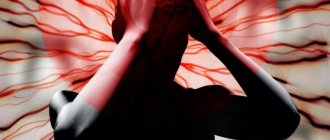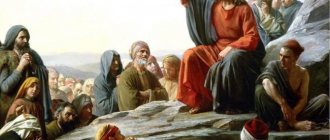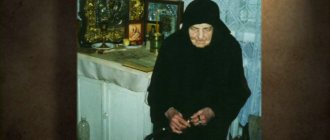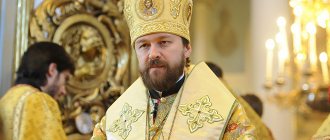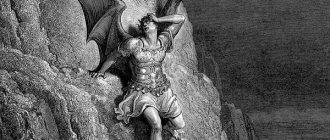Where did the devil come from
But even if you narrow the search and consider only the image of Satan, clearly separating him from other evil spirits, new difficulties arise. The fact is that the Bible does not describe the devil’s appearance, and artists had to “invent” it themselves. Moreover, in the Old and New Testaments the father of evil appears in completely different contexts. Thus, in the Book of Job, he is more of an opponent of God than His sworn enemy. The Book of the Prophet Isaiah mentions the star - Lucifer, who was cast out by the Lord from heaven for sins (but the name Satan is not used in relation to him):
“Your pride has been cast into the pit with all your noise; The worm lies beneath you, and the worms are your covering.
How you fell from the sky, Lucifer, son of the dawn! crashed to the ground, trampling the nations."
(Isa. 14, 11–12)
Finally, the Book of the Prophet Ezekiel describes the king of Tire, who at first “was in Eden, in the garden of God,” “was an anointed cherub,” but after “iniquity was found in him,” he was cast out by the Lord “from the mountain of God” ( Ezekiel 28:13–16).
In the New Testament, the devil not only argues with the Creator, but also tries to harm Him - and even invites Christ to become his servant:
“Then Jesus was led up by the Spirit into the wilderness to be tempted by the devil, and having fasted forty days and forty nights, he was finally hungry.
And the tempter came to Him and said: If You are the Son of God, command that these stones become bread.
He answered and said to him, “It is written, Man shall not live by bread alone, but by every word that proceeds from the mouth of God.”
Then the devil takes Him to the holy city and places Him on the wing of the temple,
and says to Him: If You are the Son of God, throw yourself down, for it is written: He will command His angels concerning You, and in their hands they will bear You up, lest You dash Your foot against a stone.
Jesus said to him, “It is also written, Thou shalt not tempt the Lord thy God.”
Again the devil takes Him to a very high mountain and shows Him all the kingdoms of the world and their glory, and says to Him: I will give all this to You if you fall and worship me.
Then Jesus says to him: Get thee behind me, Satan, for it is written: Worship the Lord thy God, and serve him only.
Then the devil left Him, and behold, the angels came and served Him.”
(Matthew 4:7–11)
For the first time, these disparate images merged together in the Vulgate, a Latin translation of the Bible made at the turn of the 4th–5th centuries by Jerome of Stridon. In it, Jesus Christ Himself is named as a witness to the fall of Lucifer from heaven.
Jerome combined at least four different characters in the figure of Satan because he relied on the interpretation of the theologian Origen. He collected information about the antagonists of God contained in both Testaments and presented a monolithic image. Thus, Lucifer the Lucifer from the Book of Isaiah, the fallen king of Tyre from the prophecy of Ezekiel, Satan the debater from the Book of Job and the devil from the New Testament became one and the same embodiment of absolute evil.
What is obsession?
Possession refers to two states: the first is associated with evil spirits, when a person is under the influence of evil spirits. The second is the subject of study by psychiatrists. Therefore, possession can be both a spiritual condition and a mental disorder.
Obsession is a state in which a person is dominated by one specific idea, thought or desire.
The Bible views obsession as the constant presence of sinful thoughts that cannot be overcome on one's own.
When a person's soul is taken over by the devil, he cannot control himself. In this case, only the church can help him.
Blue Angel and Black Man: Anthropomorphic Devil
It is not surprising that the first images of the “father of lies” were created based on his recently established “biography”. Art historians have found that the oldest surviving image of Satan is on the mosaic of the Ravenna Basilica of Sant'Apollinare Nuovo, built around 520. On it we see the Last Judgment, in which Christ separates the lambs from the goats. To the right hand of the Savior is an angel with a red halo. Next to him are obedient sheep, personifying the righteous. But to the left of the Lord, above the goats (these animals often grazed far from home and wandered into the mountains - that’s why they became a symbol of lost souls), stands an angel with a bright blue halo.
He does not look monstrous, but his location next to sinners and the unusual, opposite to the “correct” color of the glow around the head make us think that this is how the artist wanted to show the image of a fallen angel, that is, Satan.
Since the canons of the iconography of the devil in late Antiquity had not yet been established, the author of the drawing largely improvised, trusting his own imagination. The presence of a halo on a negative character should not be surprising: later, in the Middle Ages, demons, the Antichrist, and an apocalyptic beast were depicted with a halo around their heads. This graphic element served as a marker not only of holiness, but also of supernatural power in general, and sometimes as a compositional device. In addition, the author could depict Lucifer before his fall - and in this case he quite skillfully conveyed the angelic nature of the character, without sinning in any way against the truth.
In one of the oldest monuments of Christian iconography, the Gospel of Rabula, created in 586 in Syria, in the scene of the Savior healing a possessed man, we find the first known images of demons. This is not Satan himself, but his later minions will usually bear at least a passing resemblance to their master. The Rabula Gospel Imps are red winged creatures that resemble angels. So it is difficult to say definitely how people imagined the devil in that era, especially since at this stage European art takes a pause of three long centuries.
In the 8th or 9th century Bible, now kept in the Vatican Library, Satan speaking to Job is depicted as a black, wingless man. He is naked, but his thighs are covered with a bandage, and his feet are wearing blue boots. The devil is holding a large hook in his hands, with which he apparently intends to torment Job.
The enemy of the human race began to be depicted en masse only in the 9th century. In the Stuttgart Psalter, created around 820–30, we find not only numerous images of demons, but also a detailed figure of the devil himself seducing Christ in the desert. Moreover, demons and Satan are almost exact copies of each other: they have dark bodies, tousled hair and beards, hellish flames often burst out of their mouths, and, as a rule, they are winged (a hint at the breed of fallen angels).
Snakes sometimes crawl over the demons, and in the images at the end of the manuscript, their ordinary human legs begin to mutate into monstrous bird legs.
The devil, who is at the top of the hellish hierarchy, has a staff in his hands - a sign of power. Until the 11th century, Satan would be depicted as a dark-colored anthropomorphic creature with wings - no animal ears and paws, claws and horns or multiple mouths. All this indicates that the “biography” of the lord of darkness was well known. He was deprived of his elegant angelic clothes, his body color was changed from noble white to black, despised in Europe, and his face and hairstyle were made less handsome.
In the Christian East at the same time, the iconography of the devil could be completely different. In the Church of St. Barbara, now located in the open-air museum of the city of Goreme in Cappadocia, an unusual 9th-century fresco has been preserved, depicting - according to many art historians - Satan in the form of a locust. During the iconoclastic era, non-ornamental illustrations were prohibited in this region, and therefore the churches were full of crosses, squares, circles and plants. Locusts are one of the images of the Apocalypse, traditionally associated with evil. In a region familiar with this insect first-hand, the negative connotations could be even stronger. And in Western art, the devil began to acquire animal features only two centuries later.
Can the devil, as a representative of the spiritual world, interfere in the affairs of the material world?
The Lord in His Word gives advice: “Put on the whole armor of God, so that you can stand against the wiles of the devil; For we wrestle not against flesh and blood, but against the rulers, against the powers, against the rulers of the darkness of this world, against spiritual wickedness in high places” (Eph. 6:11-12). It is clearly stated here that the devil and fallen angels are part of the world of spirits, but at the same time they actively interfere in the affairs of the material world.
Goat-footed and dog-headed: bestial devil
At the beginning of the 11th century, the image of Satan in European culture changed dramatically and began to vary quite widely. For example, in the Barberini Psalter, created around 1050, in the same scene of Christ healing the possessed, there are not only demons flying out of the man’s mouth, but also Satan himself, defeated and bound by the Savior.
This is a half-naked zooanthropomorphic creature with a red body, gray hair, a bald head and a snout resembling a dog.
In an English manuscript of the 11th century, the devil appears in a completely different guise: he is depicted as a giant with a hairy back (in the texts of that time his fur was compared to tongues of flame) and disheveled hair, without a single bestial feature. But it’s not so easy to discern something human in the figure of Satan from the Spanish commentary on the Apocalypse (11th century) - the character’s legs and arms are equipped with sharply sharpened claws and look more like the paws of an animal, a short tail sticks out from his butt, and his nose resembles a beak. The last detail is by no means accidental - at that time Jews were depicted as ugly and big-nosed, and, most likely, the author intended to draw this visual parallel. Black, grey, brown, blue or violet, Satan with his colors of night and disease opposed the red or white angels embodying heavenly fire and the light of God.
In the same century, some devils began to develop horns. Tiny at first, they later become the dominant feature of the image. Together with claws, animal ears and paws, a tail, and from the 12th century also bat wings instead of angelic ones, these details formed the appearance of the devil throughout the Middle Ages. The “bestialization” of Satan seems completely logical: how else could artists depict the base essence of the enemy of the human race who fell from heaven?
Horned, tailed, goat-footed and hairy, the devil sometimes resembled the ancient god Pan to such an extent that some researchers talk about the continuity of images (while others believe that Satan “descended” from satyrs, jester-athletes and the winged Eros in Greek vase paintings). And they explain it this way: in Antiquity, when a new faith was just beginning to spread throughout the Roman Empire, evil began to be associated with the old, pagan pantheon. Christian theologians never tired of repeating that by worshiping the statues of traditional Roman celestial beings, people were paying homage to Satan himself. Those of them whose cult was associated with dissolute rituals were especially denounced - for example, Pan, who stood out from the rest with his indecent behavior and bestial appearance, and therefore became a symbol of the evil that Roman polytheism allegedly concealed within itself.
However, in reality, we do not find a single image of Satan similar to Pan created before the 11th century, when ancient pagan iconography was already forgotten. Probably, medieval miniaturists painted horns and hooves not because they were trying to copy the image of a goat-footed god, but because of the texts that were circulating in their time, where the most selective epithets and animal comparisons were used in describing the devil.
These prose and poetic apocrypha told in detail about all stages of Satan’s life - from the establishment of his own throne “in the north of heaven” and subsequent casting into hell to his confrontation with Christ in the desert.
The pan-shaped devil in the miniature from the famous Psalter of Queen Ingeborg invites the 6th century saint Theophilus of Cilicia to enter into a deal with him. He agrees, and they conclude a special pact (today historians actually find agreements with Satan in the archives, written in blood). Later, having repented, Theophilus begs forgiveness from the Mother of God, who breaks the contract.
The episode of the fall of angels aroused particular interest among theologians and representatives of art. The learned abbot Elfric the Grammar, who lived in the 10th century, suggested that the Lord created not nine, but ten ranks of these creatures - and one of them was precisely the very army of Satan, which, because of its pride, betrayed the Creator. After which the artists began to draw one more “shelf” in the heavens, depicting the Lord’s throne: the topmost one remained empty in memory of the rebel apostates cast into the abyss of darkness.
Often miniaturists tried to show the transformation of the bodies of fallen angels. Therefore, in the images where Satan’s army is thrown into hell, the demons who have just begun their sorrowful path are absolutely identical to the former comrades who throw them down. Those that have already fallen from the sky grow horns, animal ears or clawed paws right in the air. And those who find themselves in the abyss have a more familiar appearance: black, unsightly, bestial-like creatures.
In the 12th century, Satan begins to mutate for the first time. One of the works of the medieval intellectual Hildegard of Bingen describes her “vision of the Church as the Bride of the Son of God.”
The devil crawls out of the vulva of a woman (personification of the Church) standing in a position of prayer.
From above she exudes a heavenly radiance, there is a crown on her head, and a rich robe on her body. But there are bruises on the legs, indicating the suffering of the believers. A devil with red eyes and sharp teeth protrudes from the vulva. The fallen angel Lucifer says: “My dominion will come from the womb of Woman,” referring to the Church. Thus the devil blasphemously imitates the Son of God. Having gained strength, he encroaches on the power of the Lord Himself and is defeated. This image anticipates the many faces that will grow on the body of Satan and his assistants, which will appear three centuries later.
Saggy breasts and sinners defecating: the mutant devil
During the late Middle Ages, closer to the 15th century, the devil mutates at an alarming rate. It is no longer a small black silhouette and not just a half-beast, half-man. Satan is increasingly losing his wings, as if as a sign that he will never return to heaven. Instead, he has pendulous breasts with woolly nipples, bird feathers or tails, bushy eyebrows and ear hair, as in an illustration from Otto Heinrich's Bavarian Bible (circa 1430).
Satan is increasingly portrayed as suffering - even while tormenting sinners in hell, he himself experiences torment. In the manuscript “The Mirror of Human Salvation,” created in the 1430s–50s in Catalonia, the bound devil has two mouths: the second is located in the crotch and, with a frozen grimace of horror, chews with the sharp fangs of an inhabitant of the underworld. Two more muzzles grow directly from the knees, and below are either bird or toad paws with long claws.
This composition was repeated in many paintings of the Last Judgment in European churches - for example, in the fresco in the Cathedral of Bologna, for which the artist Giovanni da Modena depicted the Muslim prophet Muhammad next to the devil among sinners. A snake is entwined around his naked body, a symbol of vice.
Not long ago, terrorist attacks aimed at destroying the controversial work were prevented, and Islamic radicals are not tired of suing and demanding a ban on this image.
Bound Satan also appears in the miniature for the popular literary work “The Vision of the Knight of Thundal,” created in 1475 in Ghent. A tree-like devil with hundreds of paw-branches reclines on a hot grate inside the mouth of a personified hell, suffering no less than the rest, and a horned toad, a snake-tailed dog and a small imp silently look at him from the threshold.
Such attention was paid to the images of Satan in the late Middle Ages because during this period famine and plague raged throughout Europe, numerous Christian heresies won an increasingly large audience, and Muslims won victory after victory. Apparently, for the same reasons, theologians then often touched upon the problem of active evil: the devil not only waits for sinful people, but also aggressively interferes in their lives, trying to get as many souls as possible.
How to identify an obsessed person
Signs of obsession can manifest themselves on both a physical and spiritual level.
For example, a person’s voice may change greatly, as if someone else is speaking for him. Sometimes he imitates animals, for example, barks. Temporary paralysis of the entire body or individual parts may occur. Sometimes there are incredible manifestations of strength: a possessed person can lift enormous weights, easily free himself from ropes and chains, if he is tied up and shackled, he can easily scatter several people leaning on him. Also, in some cases, the possessed person’s eyes change color, they become cloudier, and the color of the skin darkens. Others develop a huge belly, like dropsy, and may experience weight loss. Sometimes paranormal abilities appear: the victim levitates, speaks non-existent languages, writes under the dictation of spirits, and may smell of sulfur. Spiritually, serious changes are also taking place. Obsession can manifest itself in the form of obscene thoughts or behavior, hatred of God, religion and religious paraphernalia. Many demoniacs cannot enter the temple, touch crosses, icons, candles, or holy water. During divine services, they can begin to rush about, howl, sob, shout blasphemous speeches, and curse, as the devil tries to protect their soul from divine influence.
Three-faced and upside down: the devil king
In many medieval images, for example in a French manuscript from the mid-15th century, we see a three-faced devil. So the artists tried to show that the ruler of evil was parodying the Trinity Itself. The fact that this monster is still not the triune God, but the Antichrist or the devil, is indicated in the iconography by numerous demonic attributes: rearing or flame-like hair, snakes that he holds in his hands, plants sticking out of his mouth, etc.
In 13th-century French Moral Bibles and later manuscripts, a three- or even seven-faced Satan or Antichrist is often enthroned with a huge sword drawn, his crown bristling with thorns, revealing the true nature of the unrighteous king. Because of their desire for rationalization, structure, and hierarchy, miniaturists depict a devil who presides over the underworld just as God dominates heaven.
After the enormous success of Dante Alighieri's Divine Comedy, completed around 1321, the chaotic universe of hell is brought into order. The underworld in iconography also begins to be divided into clear levels, ditches and crevices, and this hierarchy is completed by the figure of Satan standing upside down in the last circle of hell:
And I became speechless from amazement, When I saw three faces on it; One is above the chest; its color was red; And above one and above the other shoulder, two adjacent to this one threatened to the sides, Closing at the back of the head under the crest. The face to the right was white and yellow; The color on the left was like those who came from the Nile waterfalls.
How to get rid of obsession?
It is generally accepted that one can get rid of demon possession with the help of fasting, the cross and prayer, but this is not always enough. There is a special ritual for driving out the devil, popularly known as exorcism.
This ritual cannot be performed by any person, moreover, not every priest has the right to do this. The ritual necessarily requires special prayers, fumigation with incense, and anointing.
During an exorcism, the possessed person can show unprecedented strength of resistance, which is why, as a rule, several clergy are present.
Tongue in the crotch and invisible horns: the devil-monster and the devil-trick
The late medieval devil became increasingly exoticized and acquired grotesque features. His minions are not far behind Satan - they come in a variety of colors (sometimes all at the same time) and shapes.
Horns grow not only on their heads, but also on their butts, tongues protrude from their crotches, and tufts of incredible size rise on the tops of their heads.
The devil is beginning to be portrayed among people more often. He penetrates everywhere, even into the houses of saints, reads sermons in churches and tries in every possible way to win humanity over to his side - either on his own or with the help of his minions and the Antichrist. His cunning is so great that he skillfully hides under different guises, and his hellish nature is sometimes revealed only by a tail or a bird’s paw inadvertently sticking out from under his coat.
However, often artists painted the devil without cuts, meaning that the people around him did not see his true essence. For example, on the altar by the Italian artist Antonio Vivarini, created in the mid-15th century, St. Peter the Martyr expels a demon who has taken the form of the Madonna and Child or possessed their statue. We clearly see the devil's tail, horns and wings, but it was implied that people standing in the church could not see the machinations of Satan.
In an early 16th-century fresco by Luca Signorelli located in a church in Orvieto, the devil whispers words of sermon to the Antichrist.
The latter’s portrait resemblance to Jesus is no coincidence: he had to imitate all the acts of the Messiah, including His death and resurrection, so that people would believe him and leave the true path.
However, the false prophet is given away by demonic features of his appearance: his curls clearly hint at horns. In addition, the Antichrist is dressed in yellow, and in medieval iconography, outfits of this color were usually “worn” by the main enemies: Jews, Muslims and Judas. Some art historians believe that Luca Signorelli portrayed the Italian reformer monk Savonarola in the image of Satan.
How to cast out a demon?
If you realize that there is someone possessed by a demon in your environment, you should try to help her. Moreover, such people themselves dream of getting rid of the scourge that eats them from the inside, destroys their psyche and life.
You have two options - turn to God or try to solve the problem using esoteric practices. It all depends on your faith and religion.
How does the church rite of exorcism take place:
- The priest reads a special prayer, not paying attention to the howling, swearing and seizure of the possessed. The ritual lasts quite a long time. During the process, anointing is performed and incense is lit - its aroma is considered the best for exorcism.
- During the ritual, the possessed may writhe in pain, scream, lose consciousness, and throw himself at the priest. Therefore, the latter definitely needs assistants who, if anything happens, will restrain the possessed person.
If you are for a scientific approach, then you can try to solve the problem with the help of a psychotherapist. It may take several years of psychotherapy. A specialist will help you work through all the negativity that has accumulated in the subconscious and prescribe medications that curb aggression.
Faith, prayer and strict fasting are “maintenance therapy” that will prevent the demon from re-entering the consciousness of the former possessed person after healing.
Grotesque Hybrids: The Devil of the Old Masters
Impressed by frescoes, altar panels and miniatures in the same grotesque and baroque way, famous artists Hans Memling, Jan van Eyck, Hieronymus Bosch, Pieter Bruegel and others began to depict Satan. Assembled from many disparate body parts, this character becomes more funny than scary or majestic.
Memling's Devil, painted around 1485, is on the polyptych to the left of the Lord. He seems to be dancing with bird paws on sinners baking in the mouth of a personified hell, his hands are strewn with numerous spikes and claws, and a second face looks directly at the viewer from his stomach.
In van Eyck’s diptych “The Crucifixion and the Last Judgment” (1430), the entrance to hell represents Death in the form of a winged skeleton, which is literally defecated by sinners into fiery Gehenna, where demons of various stripes are already waiting for them. Among them it is difficult to discern the central figure, but one, on the left, is noticeably larger than the others - most likely, this is Satan. His body resembles the carcass of a dragon, deer antlers grow from his head, and flames burst out of his mouth.
Hieronymus Bosch's Devil from the triptych "The Garden of Earthly Delights" (1510) is even more exotic: made in a late medieval manner, it resembles a hybrid of a bird, a goat and a plump man.
Soul-devouring Satan sits on a “toilet” throne and defecates on sinners.
Bare Loins: Romantic Devil
The evolution of the devil ended the same way it began. After the publication of the English writer John Milton’s poem “Paradise Lost” in 1667, which detailed the history of the confrontation between Satan and God, the image of the evil spirit began to be romanticized. He is again beginning to be depicted as an angel, usually a muscular and extremely pleasant man, without any elements of the grotesque. This is no longer a hybrid or a monster. True, a characteristic detail - horns or wings - sometimes still reveals the devil in the handsome man.
One of the sexiest images of Satan was created in 1842 by the Belgian sculptor Joseph Gefs for the Cathedral in Liege. His “Genius of Evil” was a naked young man with bat wings.
The devil turned out to be so beautiful that the local bishop asked to remove the statue from the church. The newspapers trumpeted that such a Satan could distract young girls from prayer and preaching.
In 1848, Joseph Gefs's brother Guillaume made another image of the lord of the underworld - it was supposed to replace the too beautiful statue in the Liege Cathedral. His Satan is crying, a bitten apple is depicted instead of a serpent, the character is more muscular and not so young, and the demon’s loins are hidden under a veil - so as not to embarrass the parishioners. A chain is attached to his leg, with which he is chained to the rock. If you look closely at the hair, you can see small horns. The bishop, after carefully inspecting the work, accepted the sculpture, which still adorns the Liege Cathedral.
In 1847, the French artist Alexandre Cabanel painted the painting “Fallen Angel”. On it, Satan is again depicted as a man with a luxurious body, and the traditional wings of a bat are replaced by bird wings, which brings this figure even closer to the image of a heavenly messenger.
In 1866, Gustave Doré made engravings for the work of John Milton: in them the devil is as majestic as his pious brothers, and differs from them only in the shape of his wings and color.
In 1885, the luxurious “Fallen Angel” fountain by Ricardo Belver appeared in Madrid. Prior to this, the statue received many awards and was exhibited for some time in the Prado Museum. Bellver's Devil is indecently naked, with a snake wrapped around his ankle and wrist, and bird wings protruding from his shoulders.
The German artist Franz von Stuck depicted a darker and more mysterious Satan in a painting from 1890: his wings consist of black feathers, and his eyes seem to glow from within with the flames of hell.
The devil in Sascha Schneider's painting "The Triumph of Darkness" (1896) is muscular, bearded and almost completely naked. The artist shared the ideas of naturism, whose representatives called for being in the lap of nature without clothes and sang the cult of health and physical strength in art.
Following painting, romantic tricksters appear in literature. Mephistopheles and Woland finally consolidate a new type of Satan - a demonically attractive man. So the devil, who in Antiquity was depicted as a cherub, in the Middle Ages as a beast, a pan-shaped monster or a grotesque and funny hybrid with a face on his ass, again became a majestic angel.
